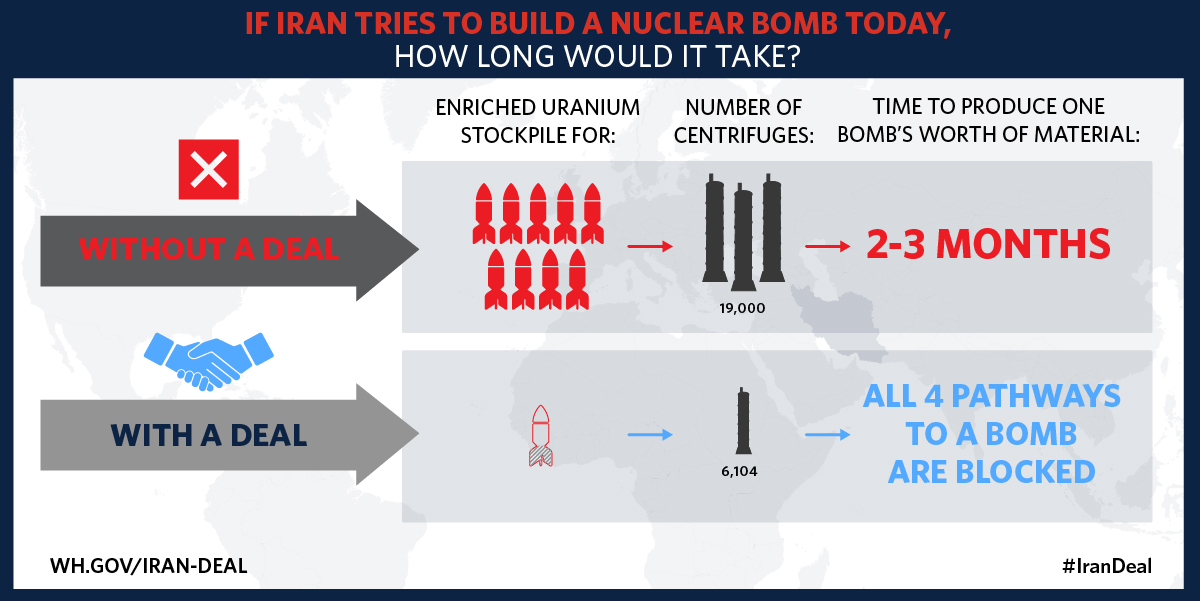|
![]()
| (1) Blocks highly enriched Uranium pathways at Natanz & (2) Fordow Component1 #400321
| - Iran would need two key elements to construct a uranium bomb: tens of thousands of centrifuges and enough highly enriched uranium to produce enough material to construct a uranium bomb. [1]
- There are currently two uranium enrichment facilities in the country: the Natanz facility and the Fordow facility.
- Let’s take a look at Iran’s uranium stockpile first. Currently, Iran has a uranium stockpile to create 8 to ten nuclear bombs.
- But thanks to this nuclear deal, Iran must reduce its stockpile of uranium by 98%, and will keep its level of uranium enrichment at 3.67% -- significantly below the enrichment level needed to create a bomb.
- Iran also needs tens of thousands of centrifuges to create highly enriched uranium for a bomb. Right now, Iran has nearly 20,000 centrifuges between their Natanz and Fordow facilities. But under this deal, Iran must reduce its centrifuges to 6,104 for the next ten years. No enrichment will be allowed at the Fordow facility at all, and the only centrifuges Iran will be allowed to use are their oldest and least efficient models.
- In short, here’s the difference the deal will make:

|
+Citations (1) - CitationsAdd new citationList by: CiterankMapLink[1] The Historic Deal that Will Prevent Iran from Acquiring a Nuclear Weapon
Author: White House
Publication info: 2015 July
Cited by: David Price 11:01 PM 30 July 2015 GMT
Citerank: (7) 400309Joint Comprehensive Plan of Action (JCPOA)The Joint Comprehensive Plan of Action (JCPOA) [5] is a comprehensive agreement on the nuclear program of Iran signed in Vienna on 14 July 2015 between Iran, the P5+1 (the five permanent members of the United Nations Security Council—China, France, Russia, United Kingdom, United States—plus Germany), and the European Union. [4]959C6EF, 4003151. Deal blocks the four pathways to a nuclear weaponBuilding a nuclear bomb requires either uranium or plutonium. But under the terms of the July 2015 deal, Iran’s four possible ways to leverage those fissile materials are blocked. [1]109FDEF6, 400328(3) Blocks the weapons grade plutonium pathway at the Arak reactor109FDEF6, 400329(4) Blocks covert attempts to produce fissile materialInternational inspectors will monitor Iran's nuclear program at every single stage.109FDEF6, 4003301. What Iran’s nuclear program would look like without the dealIran has a large stockpile of enriched uranium and nearly 20,000 centrifuges, enough to create 8–10 bombs. If Iran decided to rush to make a bomb without the deal in place, it would take 2–3 months until they had enough weapon-ready uranium (or highly enriched uranium) to build their first nuclear weapon. Left unchecked, that stockpile and that number of centrifuges would grow exponentially, practically guaranteeing that Iran could create a bomb—and create one quickly—if it so chose. [1]8FFB597, 4003312. Iran's commitments under the dealThis deal removes the key elements needed to create a bomb and prolongs Iran’s breakout time from 2-3 months to 1 year or more if Iran broke its commitments. Importantly, Iran won’t garner any new sanctions relief until the IAEA confirms that Iran has followed through with its end of the deal. And should Iran violate any aspect of this deal, the U.N., U.S., and E.U. can snap the sanctions that have crippled Iran’s economy back into place. [1]109FDEF6, 4003322. What Iran’s nuclear program will look like under the dealThe deal makes a significant difference to Iran's nuclear program. [1]8FFB597 URL:
|
|
|